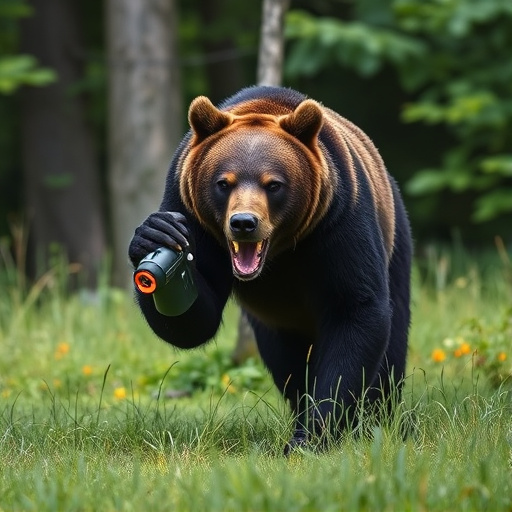Understanding bear behavior is key for safety in bear habitats. Bear spray, with its active ingredient (capsaicin) percentage ranging from 2-20%, acts as a deterrent but should be used as a last resort alongside proactive measures like noise-making and following local regulations to minimize attack risk. Proper application techniques are vital for effectiveness.
“In regions where bears roam, understanding how to prevent outdoor attacks is vital. This comprehensive guide delves into bear attack prevention spray, a crucial tool for outdoor enthusiasts. We explore ‘Understanding Bear Behavior’ and decipher the ‘Science Behind Bear Spray’, focusing on active ingredient percentage as the key to effectiveness. Learn how to choose the right spray and master application techniques for maximum protection. Additionally, discover safety tips and precautions beyond just spray usage.”
- Understanding Bear Behavior: Knowing Your Potential Enemy
- The Science Behind Bear Spray: Active Ingredient Percentage Explained
- How to Choose the Right Bear Spray for Your Needs
- Application Techniques: Ensuring Maximum Effectiveness
- Safety Tips and Precautions: Preventing Attacks Beyond Spray
Understanding Bear Behavior: Knowing Your Potential Enemy
Understanding bear behavior is a crucial step in preventing and managing potential encounters, especially when venturing into their habitats. Bears are wild animals with complex instincts driven by their natural routines and food sources. Knowing your potential enemy means recognizing that different species of bears have distinct behaviors. For instance, grizzly bears tend to avoid humans unless they feel threatened or are protecting their young. In contrast, black bears may be more curious and may approach humans out of curiosity or in search of food.
When considering bear spray as a deterrent, it’s essential to understand that its effectiveness depends on the active ingredient percentage. Bear spray typically contains capsaicin, which is derived from chili peppers. A concentration of 2-4% capsaicin is generally recommended for deterring bears, as it irritates their eyes and respiratory system, causing them to retreat. This knowledge empowers outdoor enthusiasts to make informed decisions about their safety and choose the right gear when navigating bear country.
The Science Behind Bear Spray: Active Ingredient Percentage Explained
Bear spray, also known as bear deterrent or bear repellent, is a crucial tool for outdoor enthusiasts navigating bear-infested territories. The science behind its effectiveness lies in the active ingredient percentage—a key factor in ensuring its success during potential encounters. Typically, these sprays contain capsaicin, the active compound derived from chili peppers, which provokes an immediate reaction when inhaled by bears.
The concentration of capsaicin varies among brands, but it’s often measured in percent. A higher percentage, such as 15% or more, indicates a stronger spray that can create a sufficient barrier between you and the bear. This potent active ingredient irritates the bear’s respiratory system, temporarily disorienting and deterring it from approaching further. Understanding the capsaicin percentage allows users to make informed choices, ensuring they’re adequately prepared for unexpected encounters with these majestic yet potentially dangerous animals in their natural habitats.
How to Choose the Right Bear Spray for Your Needs
Choosing the right bear spray is crucial for ensuring your safety in potential encounters with these powerful animals. When selecting a bear spray, one key factor to consider is the active ingredient percentage. The most common active ingredients are capsaicin, which is derived from chili peppers, and pyrethrins, synthetic versions of natural insecticides found in chrysanthemums.
Capsaicin offers a wide range of concentrations, typically between 1% and 4%, with higher percentages providing longer-lasting protection. Pyrethrins usually come in concentrations of around 0.5% to 3%. It’s important to choose a spray that matches your anticipated bear activity and the local regulations. For instance, if you’re hiking in areas known for aggressive black bears with low human familiarity, a higher concentration may be warranted. Always read labels and follow application instructions to ensure maximum effectiveness during an encounter.
Application Techniques: Ensuring Maximum Effectiveness
When using an outdoor bear attack prevention spray, proper application techniques are crucial for ensuring maximum effectiveness. Start by shaking the can vigorously before each use to ensure the active ingredient, typically a strong pepper spray or capsaicin, is thoroughly mixed. Hold the can 2-3 feet away from your face and spray in short bursts towards the bear’s face and eyes, as these areas are sensitive. Aim for continuous spraying until the bear turns away or flees.
Remember that the success of bear spray depends not only on its quality but also on how it’s used. Regularly testing and practicing your application technique can significantly improve your chances in a real-life encounter. Additionally, understanding the active ingredient percentage—typically around 10% for capsaicin—can help you gauge the spray’s potency and the range at which it’s effective.
Safety Tips and Precautions: Preventing Attacks Beyond Spray
When venturing into bear country, it’s crucial to go beyond just carrying bear spray and implement a comprehensive safety strategy. While bear spray is an effective deterrent with a potent active ingredient percentage (typically around 15-20%), it should be used as a last resort.
Take proactive measures like making noise to signal your presence, avoiding known bear habitats, securing food properly, and being aware of local regulations. Keep a safe distance from bears at all times, giving them ample space to retreat. By combining these precautions with the correct usage of bear spray, you significantly reduce the risk of an attack and ensure a safer outdoor experience in bear-inhabited areas.
When venturing into bear country, investing in a high-quality bear spray is an essential tool for self-defense. Understanding the science behind its active ingredient percentage and proper application techniques can significantly increase your safety during outdoor adventures. By following these guidelines and staying informed about bear behavior, you’ll be better equipped to navigate potential encounters and protect yourself in the wild. Remember, knowledge is key when it comes to preventing bear attacks.
